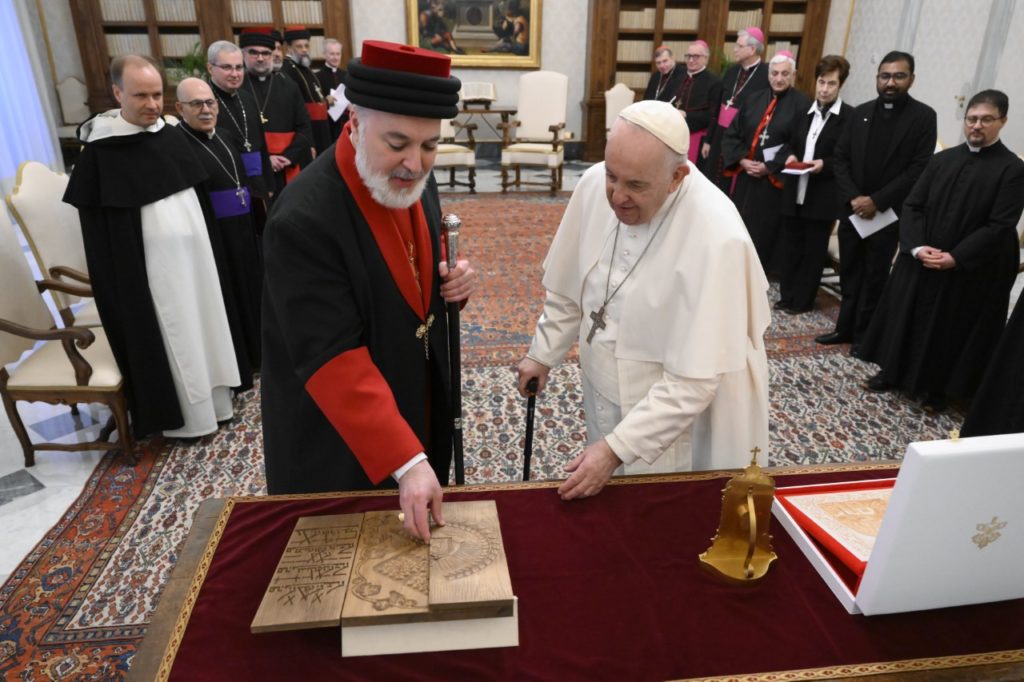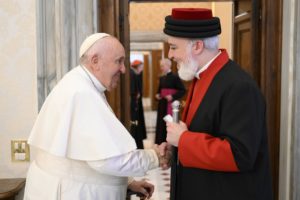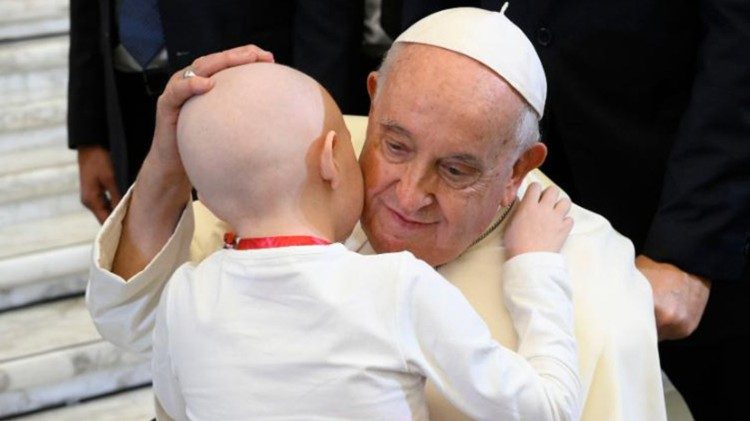“Desire to find a common date for Christians to celebrate Easter together”
Audience of His Holiness Mar Awa III, Catholicos and Patriarch of the Assyrian Church of the East with the Pope

This morning, in the Vatican Apostolic Palace, the Holy Father Francis received in Audience His Holiness Mar Awa III, Catholicos and Patriarch of the Assyrian Church of the East, and Followers.
We publish below the speech that the Pope addressed to those present during the Audience:
Address of the Holy Father
Your Holiness,
I thank you for your kind words and for this fraternal visit, the first that you are making to the Vatican as Catholicos-Patriarch of the venerable and dear Assyrian Church of the East. For Your Holiness, though, Rome is not foreign: you lived and studied here, and I would assure you, to paraphrase the Apostle Paul, that here you are no stranger or alien, but a fellow citizen (cf. Eph 2:19). Indeed, you are a beloved brother, on the common foundation of the apostles and prophets, with Christ Jesus himself as the cornerstone (cf. v. 20).
 To Christ, I give thanks for the bonds that have grown between our Churches in recent decades. They began with the numerous visits to Rome of His Holiness Mar Dinkha IV, of blessed memory: from his first visit in 1984 to that of ten years later, when he joined Pope John Paul II in signing the historic Common Christological Declaration that ended 1,500 years of doctrinal disputes about the Council of Ephesus. I also cherish a grateful remembrance of my own meetings with your venerable predecessor, His Holiness Mar Gewargis III. On his last visit to Rome in 2018, we both signed a Statement on the situation of Christians in the Middle East. I also recall our own warm embrace in Erbil, during my journey to Iraq, following the end of the Eucharistic celebration. On that day, so many believers who endured immense suffering for the mere fact of their being Christians, encircled us with their warmth and joy: the holy people of God seemed to be encouraging us on the path to greater unity!
To Christ, I give thanks for the bonds that have grown between our Churches in recent decades. They began with the numerous visits to Rome of His Holiness Mar Dinkha IV, of blessed memory: from his first visit in 1984 to that of ten years later, when he joined Pope John Paul II in signing the historic Common Christological Declaration that ended 1,500 years of doctrinal disputes about the Council of Ephesus. I also cherish a grateful remembrance of my own meetings with your venerable predecessor, His Holiness Mar Gewargis III. On his last visit to Rome in 2018, we both signed a Statement on the situation of Christians in the Middle East. I also recall our own warm embrace in Erbil, during my journey to Iraq, following the end of the Eucharistic celebration. On that day, so many believers who endured immense suffering for the mere fact of their being Christians, encircled us with their warmth and joy: the holy people of God seemed to be encouraging us on the path to greater unity!
Speaking of that journey, I would like to greet the members of the Mixed Commission for Theological Dialogue between the Catholic Church and the Assyrian Church of the East, and to express my appreciation of the work that it has accomplished to this date. From its establishment in 1994, your Commission has achieved remarkable results. I think of the study on the Anaphora of the Apostles Addai and Mari, which in 2001 permitted reciprocal admission to the Eucharist, in specific circumstances, by the faithful of the Assyrian Church of the East and the Chaldean Church, but also the 2017 publication of a Common Declaration on the Sacramental Life. Your meetings and dialogue have, with the help of God, borne good fruit and fostered pastoral cooperation for the benefit of our faithful, a pastoral ecumenism that is the natural way towards full unity.
Turning to the present, I find quite beautiful the topic of the new document you are now completing: images of the Church in the Syriac and Latin patristic tradition. You have drawn from the ecclesiology of the Fathers, which was formulated in a typological and symbolic language inspired by the Scriptures. More than in conceptual and systematic terms, the Fathers spoke of the Church using a variety of images, such as the moon, the seamless garment, a banquet, a bridal chamber, a ship, a garden, a vine… This language, simple and universally accessible, is closer to that of Jesus and consequently more lively and fitting: it speaks to our contemporaries more than many concepts. It is important that on our ecumenical journey we draw ever closer together, not only by returning to our common roots, but also by proclaiming together to the contemporary world, through our witness of life and with our words of life, the mystery of the love between Christ and his bride, the Church.
Your Holiness, your Church has in common with the Chaldean Catholic Church a luminous history of faith and mission, the exemplary life of great saints, a rich theological and liturgical patrimony and, especially in recent years, immense sufferings and the witness of many martyrs. Sadly, the Middle East is still beset by great violence, instability and insecurity, and many of our brothers and sisters in the faith have been forced to leave their homelands. Many others are struggling to remain there, and I renew with Your Holiness the appeal that their rights be respected, in particular that of religious liberty and full citizenship. In this situation, the clergy and faithful of our Churches strive to offer a shared witness to the Gospel of Christ in difficult conditions and already, in many places, they are living in almost complete communion. This is true, and it is a sign of the times, a powerful incentive for us to pray and to work diligently in preparation for the much awaited day when we can celebrate together the Eucharist, the holy Qurbana, at the same altar, as the fulfilment of the unity of our Churches, a unity which is neither absorption nor fusion, but fraternal communion in truth and in love.
 Dear Brother, Your Holiness, I know that in a few days you will deliver a talk on synodality in the Syriac tradition as part of the symposium “Listening to the East”, organized by the Angelicum, on the synodal experience of the various Orthodox and Oriental Orthodox Churches. The journey of synodality undertaken by the Catholic Church is and must be ecumenical, just as the ecumenical journey is synodal. It is my hope that we can pursue, ever more fraternally and concretely, our own syn-odos, our “common journey”, by encountering one another, showing concern for one another, sharing our hopes and struggles and above all, as we have done this morning, our prayer and praise of the Lord. In this regard, I thank your Holiness for having voiced the desire to find a common date for Christians to join in celebrating Easter. On this point, I want to say – indeed, to repeat – what Saint Paul VI said in his day: we are ready to accept any proposal that is made together. 2025 is an important year: we will celebrate the anniversary of the first Ecumenical Council (of Nicea), yet it is also important because we will celebrate Easter on the same date. So let us have the courage to put an end to this division that at times makes us laugh: “When does your Christ rise again?” The sign we should give is: one Christ for all of us. Let us be courageous and search together: I’m willing, yet not me, the Catholic Church is willing to follow what Saint Paul VI said. Agree and we will go where you say. I dare even to express a dream: that the separation with the beloved Assyrian Church of the East, the longest in the history of the Church, can also be, please God, the first to be resolved.
Dear Brother, Your Holiness, I know that in a few days you will deliver a talk on synodality in the Syriac tradition as part of the symposium “Listening to the East”, organized by the Angelicum, on the synodal experience of the various Orthodox and Oriental Orthodox Churches. The journey of synodality undertaken by the Catholic Church is and must be ecumenical, just as the ecumenical journey is synodal. It is my hope that we can pursue, ever more fraternally and concretely, our own syn-odos, our “common journey”, by encountering one another, showing concern for one another, sharing our hopes and struggles and above all, as we have done this morning, our prayer and praise of the Lord. In this regard, I thank your Holiness for having voiced the desire to find a common date for Christians to join in celebrating Easter. On this point, I want to say – indeed, to repeat – what Saint Paul VI said in his day: we are ready to accept any proposal that is made together. 2025 is an important year: we will celebrate the anniversary of the first Ecumenical Council (of Nicea), yet it is also important because we will celebrate Easter on the same date. So let us have the courage to put an end to this division that at times makes us laugh: “When does your Christ rise again?” The sign we should give is: one Christ for all of us. Let us be courageous and search together: I’m willing, yet not me, the Catholic Church is willing to follow what Saint Paul VI said. Agree and we will go where you say. I dare even to express a dream: that the separation with the beloved Assyrian Church of the East, the longest in the history of the Church, can also be, please God, the first to be resolved.
Let us entrust this, our journey, to the intercession of the martyrs and saints who, already united in heaven, encourage our progress here on earth. In this regard, I have thought to offer you, dear Brother, a relic of the Apostle Saint Thomas, a gift for which I thank Archbishop Emidio Cipollone and the Archdiocese of Lanciano-Ortona. I know that it will be placed in the new Patriarchal Cathedral of the Assyrian Church of the East in Erbil. May Saint Thomas, who touched with his hand the wounds of the Lord, hasten the complete healing of our wounds from the past, so that soon we may be able to acknowledge around the same Eucharistic altar the crucified and risen Christ, and say to him, together: “My Lord and my God!” (Jn 20:28).
I would like to say one more word. I wanted to share lunch with you, in order to conclude well, as we should, but I have to leave at 10:30. Please excuse me! I would not want it to be said that this Pope is a bit stingy and does not invite us to lunch! I would love to share the table, but there will be other opportunities. Thank you, Your Holiness, and thank you all!
Related

“You give us hope and remind us that God does not forget us” importa
Exaudi Staff
22 April, 2025
5 min

The Best Quotes from Pope Francis During His Pontificate
Exaudi Staff
22 April, 2025
3 min

Pope Francis dies of stroke and irreversible cardiovascular collapse
Exaudi Staff
22 April, 2025
1 min

More than a Decade of Service, Reform, and Hope
Exaudi Staff
21 April, 2025
4 min
 (EN)
(EN)
 (ES)
(ES)
 (IT)
(IT)

